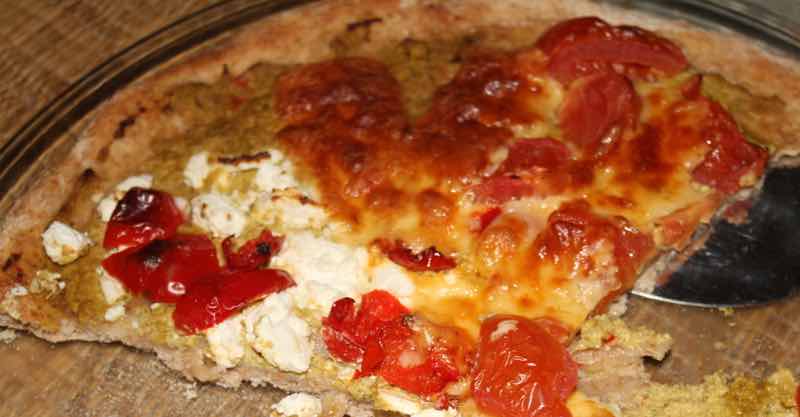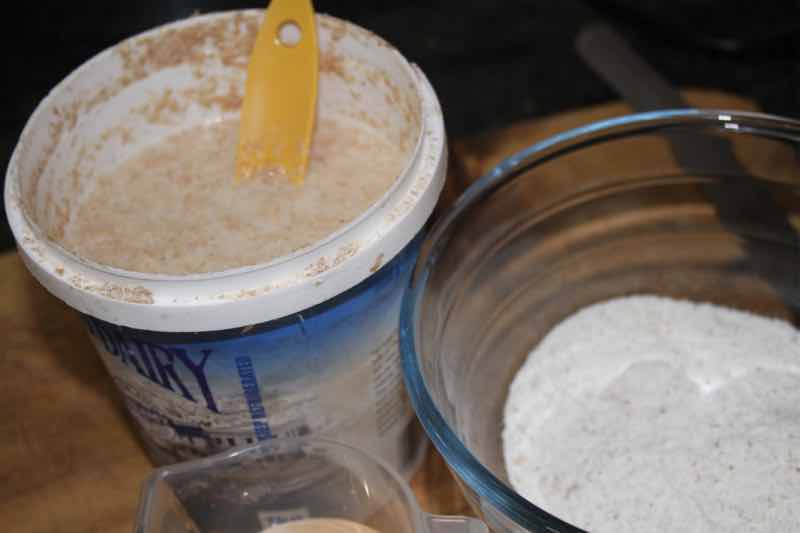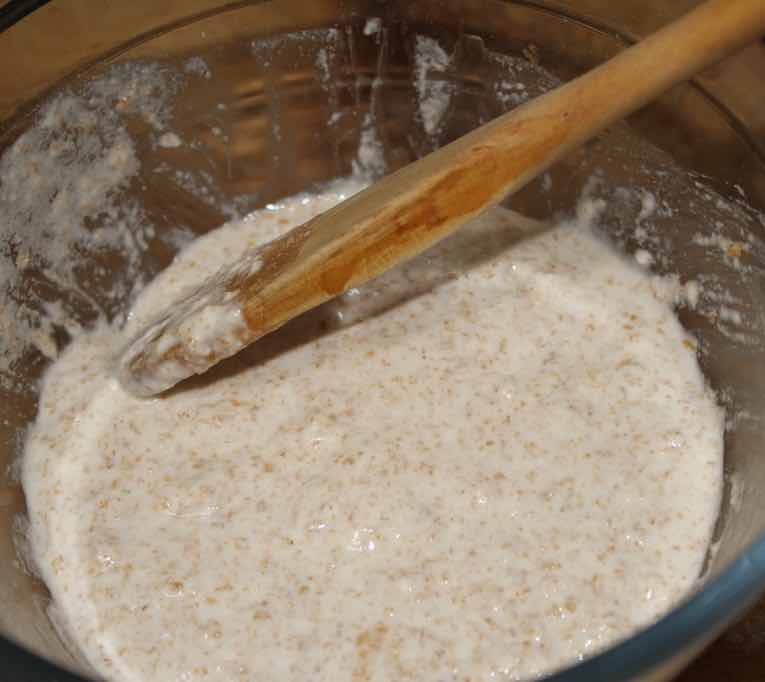- Bernard Preston homepage
- Bread
- Sourdough Pizza Crust
Sourdough pizza crust
Sourdough pizza crust has given me a new love for this Italian favourite; unfermented pastry has felt like a lump of concrete in the stomach for the last ten years.
It could be gluten-intolerance or something quite else but I have not been able to stomach pizzas, cookies and even commercial bread for that matter; until I discovered sourdough.
The frequent severe pain in the stomach at night has largely been ameliorated by the discovery of a natural probiotic called kefir that we prepare in our own kitchen. But still I have had to avoid pastries for many years, especially at supper; until sourdough pizza crust.

Step one: make the levain
- 100g wholemeal-flour[2]
- 100ml unchlorinated-water
- 30ml sourdough-culture
- Tiny pinch of dried-yeast
Weigh out the flour and pour it into a small bowl. Add the sourdough-culture and rinse the measuring spoon with the unchlorinated water into the mixture.
Add the tiny pinch of dried yeast and then use a wooden spoon to mix it thoroughly. Cut out a circle of clean food-grade plastic that was going to be trashed; cover the dough. Leave it on the counter for at least eight hours or longer.
This should take no more than five-minutes.

Step two: Make your sourdough pizza crust
- 250g wholemeal-flour
- 90ml unchlorinated-water
- The levain made in step-one
- 1 level teaspoon of salt
In a larger bowl mix the ingredients using your wooden-spoon, bar the salt.
When the dough starts coming together you can add the salt.
Lightly flour a marble-top or granite counter, tip the dough out and knead until it feels elastic but no longer sticky.
Add a little extra flour if necessary. Place your lump of dough back into the bowl and again cover with the same piece of plastic. Let it prove on the counter for a few hours; it should nearly double in size.
Press your sourdough pizza crust out onto a baking pan; cover it with a few overlapping butter-wrappings or a damp towel and let it rest for an hour or more.

Food is a journey for most of us, I suppose; then it was the discovery that if I baked my own bread by the sourdough method, using 100 percent real flour[2] that I could again enjoy a few slices.
Not too many because one slice of real bread is enough; occasionally an extra half. After two a person feels stuffed and uncomfortable; it's called satiating.
But the question was whether this would also make a sourdough pizza crust more digestible?
Indeed I can enjoy pizza again.

"Refined grains are stripped of certain nutrients like protein, the healthy fats and fibre; they have a greater effect on blood sugar levels."
- Healthline
Toppings
Coat your sourdough pizza crust first with a spicy peppadew or olive oil. You could have infused it with garlic, cinnamon or some such; perhaps another time. Slow food, made fast is our motto; so I keep it simple.
Add your favourite toppings and bake for 15 minutes in a hot-oven; you'll never go back to a conventional pizza crust.
The first-layer of the topping is a favourite sauce; the possibilities are endless. There's only one important requirement; make your own. Out of a bottle it will be laced with preservatives, sugar and salt.
I've decided to experiment and break away from the traditional tomato-based sauce; instead we are using a broad bean hummus and it turned out very successfully. Next time I am going to try a salsa de peppadew; it is spicy but not too hot. You enjoy your own favourites.
We followed that with preserved peppadews, various cheeses and sliced-tomato.
Cook in a hot oven for about fifteen-minutes; using wholemeal flour you may need a bit longer.
Gluten
Gluten usually unjustly gets the blame for the bloating and discomfort many of us have after eating commercial wheat-products; mostly this is not true since the baking industry adds toxic enzymes and various chemicals to the dough. Often they are the true culprits.
But never mind, perhaps you think you are gluten-intolerant and you could be. The amino acid called proline is the cause.
A protein consists of a long chain of molecules called amino-acids. Combined together in a unique way, by your own DNA they make up the cells in your body.
During the digestive process in the stomach and small intestine it is vitally important that they are broken down to individual units; otherwise your immune system will target them as something foreign and set up an inflammatory reaction. When serious it causes a nasty disease called Coeliac Sprue.
The amino-acid called proline is the spoke in the wheel; unlike all its cousins it has a ring structure that defies enzymatic action. If short chains of improperly digested proteins enter the blood stream, there's havoc.
The solution is pre-digestion of the gluten using a sourdough culture.
What is really important is not to forsake wheat and turn instead to other highly-refined starches. That's what many folk who think they are gluten intolerant do, with serious consequences; blood sugar soars. Make your sourdough pizza crust rather; and artisan bread too.
Levain and poolish
If you use a small amount of dried-yeast to start off your sourdough pizza crust, it's called a levain.
Without the yeast it is known as a poolish; this is how the purist would do it. It may be a little heavier. These terms are used rather loosely.
Worst foods for blood-sugar
"Regardless of whether you have diabetes, healthcare professionals generally recommend limiting your intake of refined carbs, including the white flour used to make pizza crust."
- Healthline[3]
Commercial pastries always score badly for their affect on blood-glucose, Sugar or high-fructose corn syrup are often added and too much salt; because they are tasteless after processing to remove the nutrients that give dough its magnificent flavour.
Only then is the tomato paste spread out; and it too often has excessive added sugar and salt. It's just one more reason to bake your sourdough pizza crust and make your own sauces.
HbA1c test
If you are concerned about being prediabetic then read up on the HbA1c test at our Carbs in the life of a Believer page; scroll down to the bottom. Skip the old-fashioned religion if you're not interested!
This simple blood test will reveal all.
Sourdough pizza crust
Sourdough pizza crust means better digestion of the gluten; with less bloating and little sense of rocks settling in the base of the stomach.
When browsing use right click and "Open Link in New Tab" or you may get a bad gateway signal.
Newsletter
Our newsletter is entitled "create a cyan zone" at your home, preserving both yourself and Mother Earth for future generations; and the family too, of course. We promise not to spam you with daily emails promoting various products. You may get an occasional nudge to buy one of my books.
Here are the back issues.
- Lifestyle and ideal body weight
- What are ultra-processed foods?
- Investing in long-term health
- Diseases from plastic exposure
- Intensive lifestyle management for obesity has limited value
- A world largely devoid of Parkinson's Disease
- The impact of friendly bacteria in the tum on the prevention of cancer
- There's a hole in the bucket
- Everyone is talking about weight loss drugs
- Pull the sweet tooth
- If you suffer from heartburn plant a susu
- Refined maize meal and stunting
- Should agriculture and industry get priority for water and electricity?
- Nature is calling
- Mill your own flour
- Bake your own sourdough bread
- Microplastics from our water
- Alternative types of water storage
- Wear your clothes out
- Comfort foods
- Create a bee-friendly environment
- Go to bed slightly hungry
- Keep bees
- Blue zone folk are religious
- Reduce plastic waste
- Family is important
- What can go in compost?
- Grow broad beans for longevity
- Harvest and store sunshine
- Blue zone exercise
- Harvest and store your rainwater
- Create a cyan zone at your home
Did you find this page interesting? How about forwarding it to a friendly book or food junkie? Better still, a social media tick would help.
- Bernard Preston homepage
- Bread
- Sourdough Pizza Crust
Address:
56 Groenekloof Rd,
Hilton, KZN
South Africa
Website:
https://www.bernard-preston.com